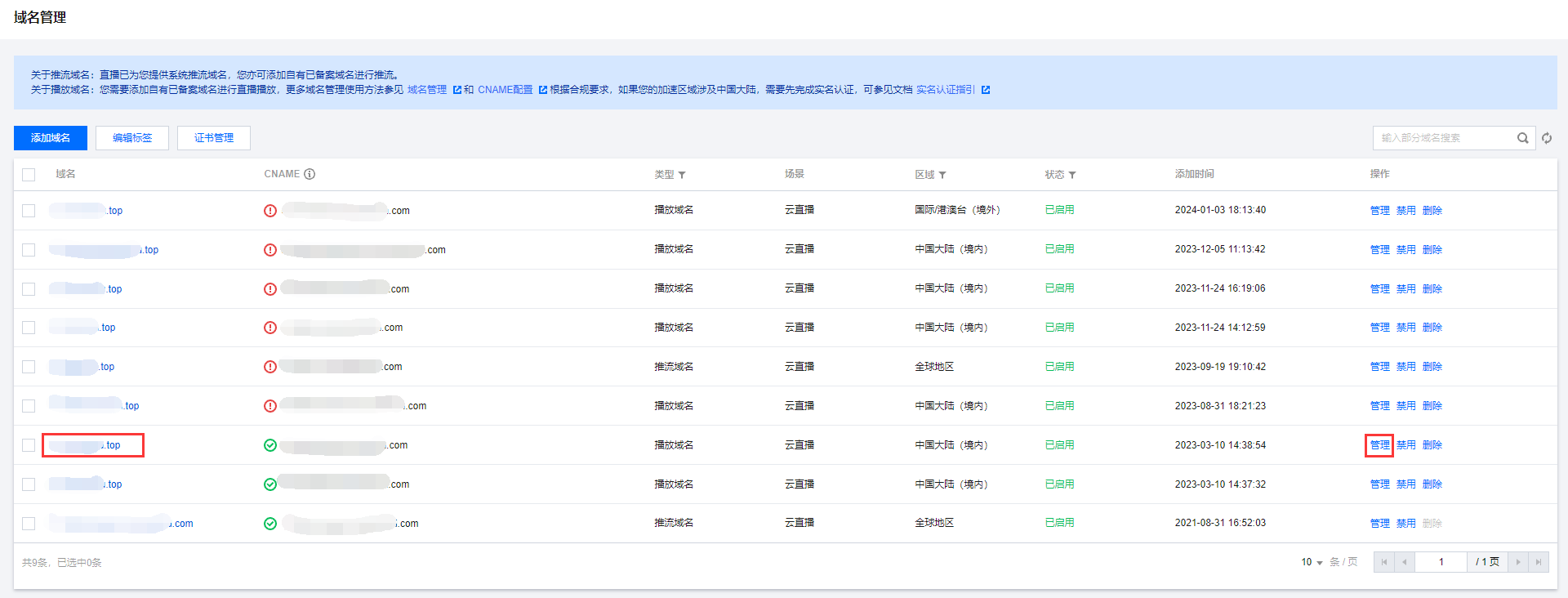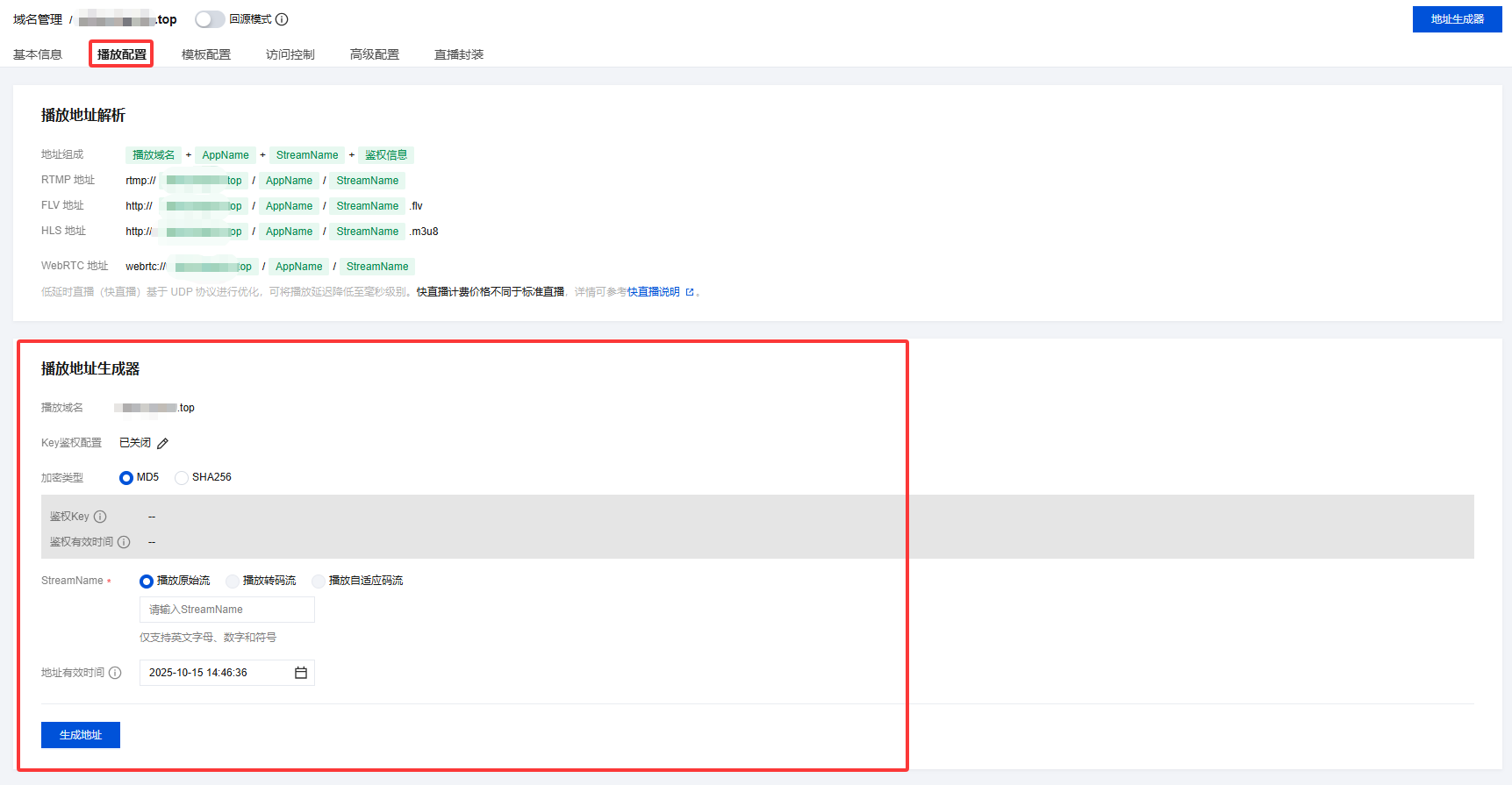播放配置
最后更新时间:2025-10-21 17:10:51
域名推流成功后,您可进入云直播控制台,使用播放地址生成器录入与推流地址 StreamName 相同的 StreamName,生成对应流的播放地址,即可通过该播放地址查看直播画面。
前提条件
已登录 云直播控制台。
已添加播放域名 ,详情请参见 添加自有域名。
操作步骤
1. 选择 域名管理,单击需配置的播放域名或管理进入域名管理。


2. 选择播放配置 > 播放地址生成器,进行如下配置:

2.1 您需要选择一种加密类型,请根据您的安全需求和性能考虑进行权衡。加密类型可以选择 MD5 或 SHA256 ,默认 MD5。
2.2 选择播放原始流、播放转码流和播放自适应码流。若选择播放转码流则可选择已配置转码模板输出转码流。若选择播放自适应码流则可选择已配置自适应码率模板输出自适应码流。
2.3 填写自定义的流名称 StreamName。
仅支持英文字母、数字和符号。
例如:liveteststream。播放地址 StreamName 要与推流地址 StreamName 一致才能播放对应的流。
2.4 若是自适应码流,则会展示自适应码率子模板名称,按码率由大到小排列。
2.5 选择地址有效时间,例如:
2025-10-15 14:46:36。说明:
地址有效时间就是鉴权信息里的 hex(time),修改会改变播放 url,地址有效时间+鉴权有效时间才是实际有效时间,超出实际有效时间后新的请求将会被拒绝,无法再通过该地址重新拉流。
3. 单击生成地址即可。

4. 若您的播放域名未开启播放鉴权,您还可以在播放配置 > 播放地址解析标签下,查看该播放域名下 RTMP、FLV、HLS、WebRTC 这四种播放地址。替换播放地址中的 StreamName(流名称)关联推流地址,关联后即可通过播放地址查看直播画面。

说明:
播放地址
播放地址生成规则
RTMP格式:rtmp://domain/AppName/StreamName?txSecret=Md5(key+StreamName+hex(time))&txTime=hex(time)FLV格式:http://domain/AppName/StreamName.flv?txSecret=Md5(key+StreamName+hex(time))&txTime=hex(time)M3U8格式:http://domain/AppName/StreamName.m3u8?txSecret=Md5(key+StreamName+hex(time))&txTime=hex(time)WebRTC格式:webrtc://domain/AppName/StreamName?txSecret=Md5(key+StreamName+hex(time))&txTime=hex(time)
domain:自有已备案播放域名。
AppName:直播的应用名称,默认为 live,可自定义。
StreamName:流名称,用户自定义,用以标识直播流。
txSecret:开启播放鉴权后生成的鉴权串。
txTime:播放地址设置的时间戳,用以控制台播放地址的有效时间。
注意:
若您开启了域名鉴权,实际过期时间 = txTime + 鉴权有效时间。
控制台为了方便使用,设置的时间即为实际过期时间。若您开启了域名鉴权,计算播放地址时会按照公式倒推出 txTime。
在过期时间前进行了推拉流,只要推拉流正常没有断开或停止,即使过期时间到了也能正常保持推拉流状态。
转码后的直播地址
若播放域名配置了转码模板,同时需播放转码后的直播流,转码的播放地址拼接方式为:在原始播放地址中的 StreamName 后增加
_转码模板名称。例如:原始播放地址为
http://domain/AppName/StreamName.flv?txSecret=Md5(key+StreamName+hex(time))&txTime=hex(time) ,关联的转码模板名称为hd,则转码播放地址为http://domain/AppName/StreamName_hd.flv?txSecret=Md5(key+StreamName_hd+hex(time))&txTime=hex(time)。自适应码率的直播地址
若播放域名配置了自适应码率模板,自适应码率目前只支持 HLS 和 WebRTC 协议,并且两个协议的自适应码率地址拼接方式不同。
HLS 自适应码率地址拼接方式:在原始播放地址中的 StreamName 后增加
_自适应码率模板名称。
例如:原始播放地址为 http://domain/AppName/StreamName.m3u8?txSecret=Md5(key+StreamName+hex(time))&txTime=hex(time) ,关联的自适应码率模板名称为 autobitrate。
则 HLS 自适应码率播放地址为 http://domain/AppName/StreamName_autobitrate.m3u8?txSecret=Md5(key+StreamName_autobitrate+hex(time))&txTime=hex(time)。WebRTC 自适应码率地址拼接方式:
播放域名(domain)+AppName(默认live)+StreamName(流ID)+鉴权信息+自适应码率子模板名列表+起始播放码率子模版名+码率切换控制方式。注意:
WebRTC 自适应码率地址参数 tabr_bitrates 也即自适应码率子模板名列表,必须按码率从高到低排列。
例如:一个自适应码率模板中,子模板1名称为:test1,码率200;子模板2名称为:test2,码率300;子模板3名称为:test3,码率400,
则 WebRTC 自适应码率播放地址为:
webrtc://domain/AppName/StreamName?txSecret=Md5(key+StreamName+hex(time))&txTime=hex(time)&tabr_bitrates=test3,test2,test1&tabr_start_bitrate=test1&tabr_control=auto
播放 H.265 的播放地址
文档反馈

